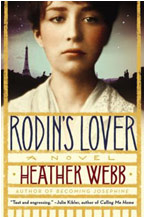 For Frenchie Friday and Beth Fish’s #WeekendCooking, Dana Gynther, author of CROSSING ON THE PARIS (Titanic meets Downton Abbey), talks about all that food aboard the oceanliner in her novel.
For Frenchie Friday and Beth Fish’s #WeekendCooking, Dana Gynther, author of CROSSING ON THE PARIS (Titanic meets Downton Abbey), talks about all that food aboard the oceanliner in her novel.
Take it away, Dana!
ONE OF THE DELIGHTS of writing “Crossing on the Paris,” set on a French Line ocean liner in 1921, was imagining the passengers’ meals. I confess, I spent far more time than was necessary researching antique steamer menus for sale on Ebay, from handwritten ones from the 19th century to those from emblematic ships like the Lusitania or the Titanic. Some dishes were mysteries to me—like Croûte au Pot or Charlotte Russe—and I had to look them up in my vintage copies of the Escoffier Cookbook and Larousse Gastronomique. I decided against using many of the fashionable recipes from the time—like sheep trotters and ox tongue—because they sound so unappealing today.
 On ocean liners meals are the key events on board. My book has three main characters—two women travelers in First and Second class and a young woman in the Service Crew—and they all had to have different dining experiences, from the elegant, multi-course meals in First to the homey ones served family-style below. They were all, however, examples of traditional French cuisine in keeping with the fashions of the 1920s.
On ocean liners meals are the key events on board. My book has three main characters—two women travelers in First and Second class and a young woman in the Service Crew—and they all had to have different dining experiences, from the elegant, multi-course meals in First to the homey ones served family-style below. They were all, however, examples of traditional French cuisine in keeping with the fashions of the 1920s.
For example, Vera Sinclair, in First Class, could enjoy velvety lobster bisque with just a hint of cognac, prime sirloin cooked rare, and Peach Melba (a trademark of Escoffier, the first “celebrity chef”) topped with fresh raspberry sauce and vanilla ice cream. In Second Class, Constance Stone, unused to foreign food, is disappointed with her cold soup, crème Vichyssoise, and disconcerted by the one-eyed stare of her fish. Julie Vernet, suffering from mal de mer (sea sickness) in Steerage, doesn’t eat but helps serve garlic soup and rabbit to hundreds of people. Solid French cooking from the most elaborated to the most humble.
ALONG WITH THE FOOD, part of the dining experience was the ambience, the clothes, the service and the conversation, which also needed to be different for each class. The First Class dining room on the Paris was a work of art, with an immense glass ceiling and a double staircase for making grand entrances. We can imagine the porcelain tableware, the fresh flowers, Chopin coming from the grand piano in the corner. In Second, for our bourgeois guests in velveteen and tweed, the ceilings were lower, the palms shorter, the service less fawning. Despite the lack of frills in Steerage, the conversation was lively at the long tables and the waitresses could occasionally join in on the joke.
Besides dinners and luncheons, for the upper classes, there were also high teas with the best French pastries, cocktails (especially those popularized in the “American” bars in Paris—martinis, sidecars, white ladies, etc), as well as the traditional on-deck snack of bouillon and saltines. After five days on board, the ship would dock in New York, and the passengers would alight, refreshed and energetic. Undoubtedly, they would also arrive with a few pounds of “extra baggage.”
 AND FOR THOSE OF US WHO LIKE HISTORICAL COOKING, Dana has shared a popular dish Vera, her first-class character, ordered aboard.
AND FOR THOSE OF US WHO LIKE HISTORICAL COOKING, Dana has shared a popular dish Vera, her first-class character, ordered aboard.
CROÛTE AU POT
1 thin baguette
Olive oil
4 and a half cups fresh beef or chicken consommé
1 onion
1 small turnip or parsnip
1 carrot
1 leek
1 stick of celery
1 garlic clove, crushed
1 large tomato
1 tablespoon finely chopped parsley
1. Slice the baguette into rounds. Brush each side with olive oil and bake until crisp and golden.
2. Pour consommé into a saucepan and heat gently.
3. Peel the onion, turnip, carrot and dice. Add to the consommé with the garlic.
4. Bring to boil, then immediately reduce heat. Cover and simmer until vegetables are al dente.
5. Peel, de-seed and finely dice the tomato and add with the parsley.
6. Place two are three “croûtes” (toasts) in each bowl, fill with soup.
A classic, the dish appeared on the Luncheon Menu of the Lusitania (see menu) but also on the sea trials of the Titanic in April, 1912.
ABOUT THE BOOK
In 1921, the Gilded Age is drawing to a close, but not aboard the great ocean liner the Paris, on its maiden voyage between Le Havre and New York. Amidst the luxurious wood paneling and plush carpets of first class is the aging Vera Sinclair, who has made the difficult decision that after thirty years in Paris she will leave her dearest friend behind and return at last to Manhattan. In the cozy family comfort of second class, Constance Stone revels in unaccustomed freedom as she returns from a brief, failed mission in Paris to her home in Worcester, Massachusetts, where her adored little daughters and dull professor husband await. And on the stifling, noisy lowest deck below the waterline, young Le Havre native Julie Vernet tests her wings in her first job—unenviably serving meals in the steering class dining room. Three very different women from very different worlds, yet aboard the Paris their lives will intersect.
Dana Gynther was raised in St Louis and Auburn, Alabama. After college, she lived in France for eighteen months, then returned to the University of Alabama to get an MA in French Literature. In 1994, she and her French-speaking Spanish husband moved to his hometown, Valencia (Spain), where they work as teachers and translators. She enjoys traveling, reading and writing, making collages, riding her bike around town, but mostly, spending time with her husband and their two daughters. Visit her website, www.DanaGynther.com for more details and ancedotes about oceanliners in the 1920’s.
****(Both the recipe and menu were taken from “The Captain’s Table: Life and Dining on the Great Ocean Liners” by Sarah Edington).
10 Comments
Join the conversation and post a comment.















What an interesting post? I’m about to begin a nonfiction title about the first class passengers on the Titanic. Crossing on the Paris could be the perfect follow-up!
It’s a fun book, JoAnn. I loved the descriptions. Dana might be a good source of information. Good luck with your book!
This is a great review! You have definitely piqued my curiosity and I’m going to look for this one.
Ooh, I loved this post! Wonderful to read about what sort of meals they had – must have been amazing, once-in-a-lifetime sort of trips!
Everything about this book appeals to me. Food, French themes and an excellent review. I plan to check it out and review soon.
Lovely poster too
that sounds very interesting…those were the days. if you were very rich…
I loved this post. Even back then it seems that food was a major focus on cruises. The recipe sounds like a nice, light lunch.
A fascinating post! I am going to try that classy recipe. I guess you can get anything on ebay!
Wow! Loved this post and now I need to read this book. I would love the food and dress descriptions.